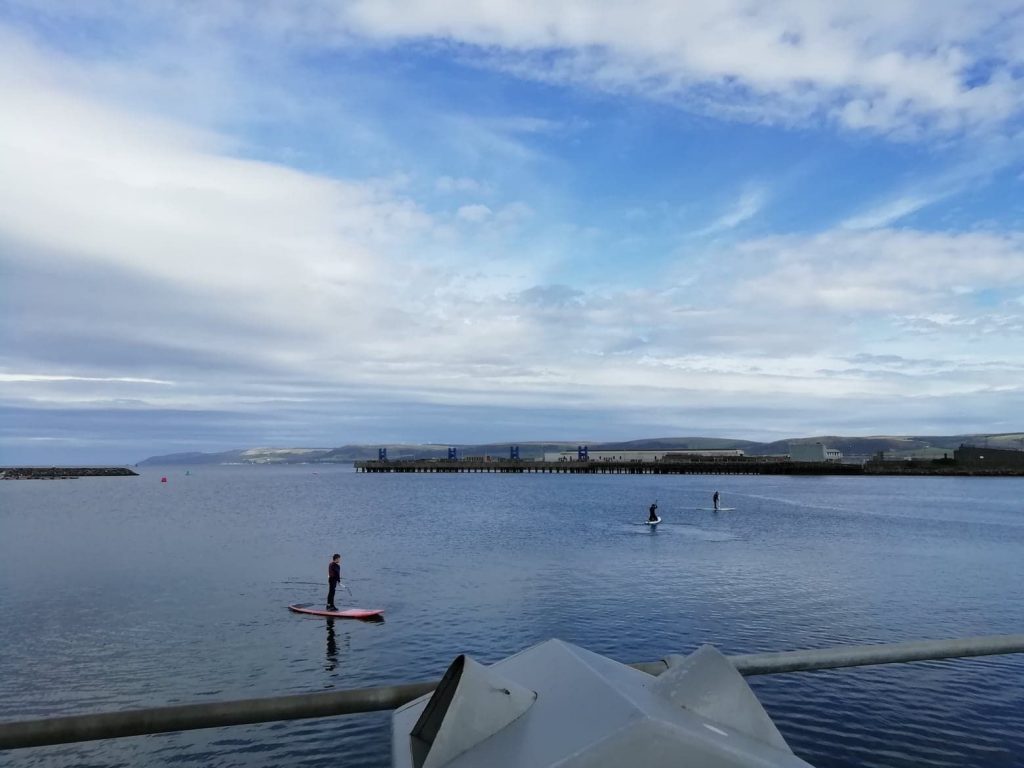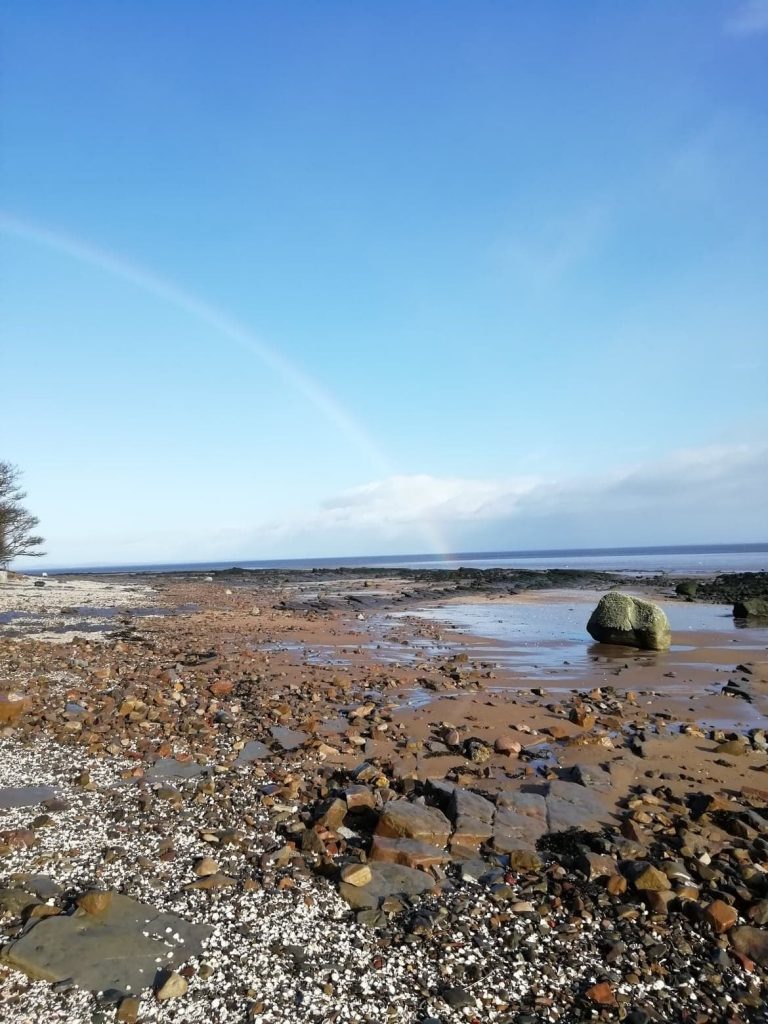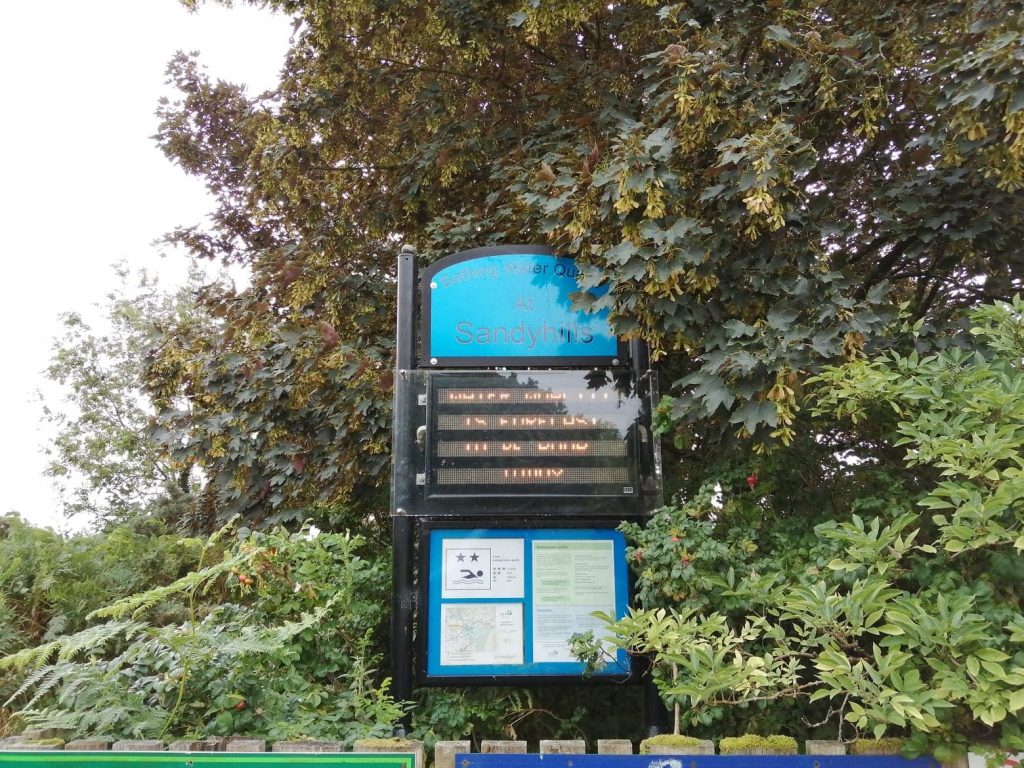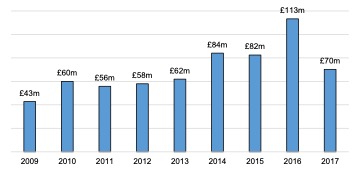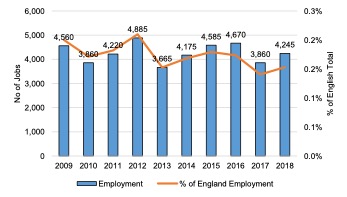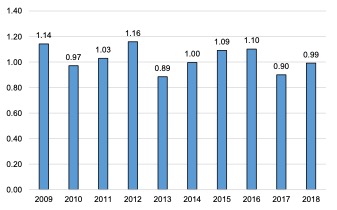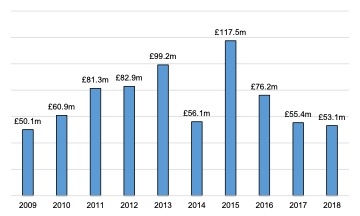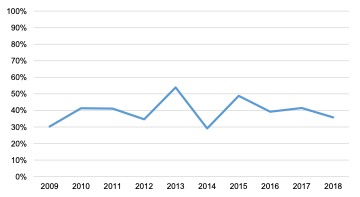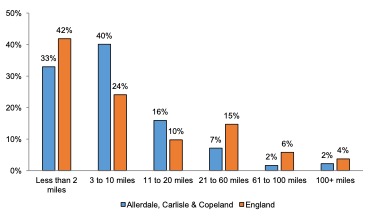Sport, recreation and tourism
Scotland - Sport, Recreation, and Tourism Activities
A wide range of marine and coastal sport, recreation and tourism activities are undertaken in the Solway Marine Region. This includes coastal walking routes, sailing, diving, wildlife watching, and beach recreation and sports. Data on certain recreational activities in the Scottish Solway recorded in 2011 can be seen in the National Marine Plan Interactive data layer; ‘Solway – Recreation Activities – September 2011‘ and can provide some visual and spatial indication of certain recreational uses of the firth at the time. A separate, and more recent, data layer has been created for Loch Ryan, and provides spatial data on recreational activities in the Loch in 2013. There is useful information on recreational use of the Solway coast between the Isle of Whithorn and Southerness as part of Rediological Habitat Surveys of the Dumfries and Galloway Coast 2012 & 2017. These surveys looked at habits and consumption patterns which may be subject to long-range effects of permitted radioactive liquid discharges into the Irish Sea primarily from the Sellafield Nuclear site in Cumbria. A variety of recreational activities are included, many of which have limited other data available such as dog walkers, people picnicking, beach combing and paddling.
Sailing
There are sailing clubs within the Scottish Solway Marine Region in Stranraer (Stranraer Water Sports Association & Loch Ryan Sailing Club), Kippford (The Solway Yacht Club), Isle of Whithorn (Wigtown Bay Sailing Club) and Kirkcudbright (Kirkcudbright Sailing Club). Most sailing activity on the Solway is seasonal (May – September).
Stranraer Water Sports Association and Dumfries & Galloway Council are developing regeneration proposals for Stranraer, with water sports and marina expansion set to play an important role. With Loch Ryan’s natural shelter providing a suitable environment for water sports, there will be a focus on developing Stranraer as a marine leisure destination. Proposals include a new training and education centre, 300 berths and improvements to the pier and surrounding public realm, linking up the shore area to the town (BBC News, 2019). This project has, in part, come about as a response to the Stena Line ferry service switching their base to Cairnryan in 2011. A feasibility study will further develop the plans in 2020.
On the other side of the Rhins of Galloway, Portpatrick Harbour has 40 resident berths and 20 visiting berths and, unlike harbours in the Inner and Outer Solway Firth, is accessible at low tide. Permission for an expanded 57-berth marina with pontoons was applied for in 2007, but this was rejected by Dumfries & Galloway Council. In 2015, the harbour was taken into community ownership, The Portpatrick Harbour Community Benefit Society, financed through a community share scheme. Mooring fees are now invested in community projects, with a new community hub at the harbour opened in 2019.
In the Solway Marine Region, there are also harbours at Port Logan, Drummore, Port William, Wigtown, Kippford (with a pontoon for visitors), Isle of Whithorn, Garlieston, Kirkcudbright and Annan. Kingholm Quay, and Glencaple pier are located up the river Nith towards the town of Dumfries, approximately 2 and 5 nautical miles, respectively, from the river mouth into the Solway. Both Kingholm Quay and Glencaple pier have limited use as they are tidal and difficult to access. Kingholm Quay is used primarily for pleasure crafts since it was brought back into use through works on the sluices. Glencaple is where the independent and voluntary Nith Inshore Rescue is based. Port William, Isle of Whithorn, Garlieston, Kirkcudbright, and Stranraer are all the responsibility of Dumfries and Galloway Council. Facilities for visiting sailors are generally limited at these locations. An exception to this is Kirkcudbright, a busy fishing port, has more extensive facilities with 40 moorings and 50 pontoon berths. The Sailing Tourism in Scotland study identified that waiting lists are in operation for spaces at Stranraer, Kirkcudbright and Portpatrick (EKOS Ltd, 2016).
Annan Harbour, in the upper Solway, has recently been the focus of regeneration efforts by the local community. Led by the Annan Harbour Action Group, funds have been raised to promote and develop the harbour, with the group organising a range of marine and shoreside activities, including an annual festival, for this purpose. The harbour had fallen out of use in the 1980s and silted up, but was reopened in 2015 after a new channel was dredged and it is now able to accommodate visiting leisure crafts (Yachting Monthly, 2015).
However, sailing opportunities in the Scottish Solway are still limited by the small, silted harbours and tidal river estuaries in the Firth itself. While dredging is one solution to this, it requires ongoing and expensive work. Outside of the Firth, the North Channel can also experience rough seas that would be off-putting to less experienced sailors. Sailing activities tend to be within 5km of the coast.
Automatic identification system (AIS) tracking data shows a low intensity of leisure sailing in most of the Solway. There is a slightly higher level between Kirkcudbright and Whitehaven, which is unsurprising given that both have yachting facilities, and are in the North Channel. While most recreational boaters do not have AIS (the Royal Yachting Association estimate around 10% have it in place), the data provides a useful indication of where activity is concentrated. This data can be viewed here; ‘Leisure and Recreation – Recreational AIS intensity – RYA UK Coastal Atlas of Recreational Boating – September 2019‘. There is also known to be a popular trans-Solway sailing route between Kippford and Maryport. This route is not seen on the data layer, but as previously mentioned, most recreational boaters do not have AIS.
Other Water Sports and Diving
Other examples of water-based activities in the region include Kirkcudbright Canoe Club, Annan Harbour Rowing Club and Newton Stewart Sub Aqua Club.
Stranraer Water Sports Association brings together a number of different groups who undertake water sports activities in Loch Ryan. This includes Stranraer Coastal Rowing Club, an outdoor swimming group, and informal paddle boarding, kayaking and kite surfing groups. Maps of recreational sub aqua activity, sea angling, surfing and sailing in Loch Ryan (as of 2014) were made available in the 2014 Loch Ryan Management Plan, available here.
In 2020, Scotland’s Year of Coasts and Waters is being marked with a coastal rowing baton relay around Scotland (ITV News, 2019). This was to be launched from Gretna, with Annan Harbour Rowing Club taking it as far as Stranraer, where rowers would take the baton onwards to Kintyre. This event was replaced with a virtual RowAround Scotland due to COVID-19 restrictions in 2020.
As noted, the Water Sports Association are investigating the potential for a new Training, Education and Regatta Centre at Stranraer Waterfront.
Beaches and Bathing Waters
Scotland has 86 designated bathing waters where the Scottish Environment Protection Agency (SEPA) monitor water quality from 15 May to 15 September each year. Seven of these are within the Solway Marine Region, all located on the stretch of coast between Gatehouse of Fleet and Southerness. In 2018/19, three were graded as ‘good’ and four as ‘poor’, see table below.
The classifications are normally calculated on four years of monitoring data, to give a more consistent picture of water quality condition of each protected area location, using the two key mandatory microbial parameters of Escherichia Coli (E coli) and Intestinal Enterococci (IE). Each beach is then scored according to a European Union grading system as poor, sufficient, good or excellent. An excellent resource is the interactive map available from the European Environment Agency which provides a map of bathing water quality at designated sites across Europe, but when zoomed in to the Solway shows each designated beach, and provides additional data such as the quality rating for the past 10 years, site ID, and more.
| Scottish Solway:Bathing Water Quality (2015/16, 2017/18 & 2018/19) |
|
2015/16 |
2017/18 |
2018/19 |
| Carrick |
Good |
Good |
Good |
| Mossyard |
Poor |
Good |
Good |
| Southerness |
Good |
Excellent |
Good |
| Brighouse Bay |
Good |
Poor |
Poor |
| Dhoon Bay |
Poor |
Poor |
Poor |
| Rockcliffe |
Poor |
Poor |
Poor |
| Sandyhills |
Poor |
Poor |
Poor |
Source: Scottish Environment Protection Agency (n.d.).
Keep Scotland Beautiful co-ordinates a Beach Award scheme, with nominations put forward by local authorities, community groups and other agencies. Of 61 beaches awarded in 2018, none were in Dumfries & Galloway.
Scottish Water provides most waste water collection and treatment services in Scotland. A number of improvements to local sewage works and public septic tanks have been undertaken in the area in recent years, with the aim of improving bathing water quality. For example, upgrades to the waste treatment centre at Kippford have been identified as crucial for improving water quality at Rockcliffe.
As agriculture is the dominant land use in the area, heavy rainfall can lead to outflows from the surrounding land negatively impacting on the quality of bathing waters (Scottish Environment Protection Agency, 2020). The level of pollution can also be influenced by geographical features of the coast.
Wildlife and Nature Reserves
Dumfries & Galloway is renowned for its birdwatching opportunities, particularly along the Solway Coast, with the estuary attracting large numbers of migratory birds during the winter months (wildfowl and waders). There are various natural environment designations (Sites of Special Scientific Interest, National Nature Reserves, National Scenic Areas, RAMSAR, etc) and areas of land managed by conservation agencies and charities, which is indicative of the importance of the area’s biodiversity.
There are six Royal Society for the Protection of Birds (RSPB) landholdings in Dumfries & Galloway, with four of these on the coast: Kirkconnell Merse, Crook of Baldoon, Mersehead, and Mull of Galloway. The latter two each have a visitor centre and open seasonally. Kirkconnell Merse, an area of saltmarsh on the Nith Estuary is not a visitor site, but is managed by the RSPB for conservation purposes. The RSPB employs 14 staff across Dumfries & Galloway, of which 12 are year-round roles.
The Scottish Wildlife Trust (SWT) manage seven sites, although onsite facilities are typically limited to footpaths and signposts. Two of the SWT sites are by the coast, Southwick Coast and Drummains Reedbed, with extensive birdlife.
The Wildfowl and Wetlands Trust (WWT) operate their only Scottish reserve at Caerlaverock Wetland Centre, which is open throughout the year. In 2018, it had 14,000 visitors.
Research undertaken for the RSPB at the Mull of Galloway reserve in 2010 helps to illustrates the economic impact of wildlife tourism on the Scottish Solway coast:
- around 7% of visitors said that Mull of Galloway reserve was their main reason for visiting the area, but a much higher proportion (71%, including the 7% listed it as the main reason for visiting the area) said that the reserve was among their reasons for visiting the area (Royal Society for the Protection of Birds, 2010).
Initiatives such as special trails can cause even more visitors and spend in the local area. There was also a report published the same year (2010) which indicated the economic impact on Dumfries and Galloway off ‘The Galloway Kite Trail‘ (Molloy & Rollie, 2010). This report detailed the positive economic impact the Galloway Kite Trail had for the region (between 2004 and 2010);
- a total £2.63 million new spend in the region;
- the trail was a motivation in the visits of over 10,000 people to Dumfries and Galloway
(Molloy & Rollie, 2010)
The Galloway Kite Trail is no longer being managed by the RSPB, and is not directly on the coast, this report shows the economic contribution environmental initiatives can have to the Dumfries and Galloway region.
The findings indicate that the recognised reserves and other areas for watching wildlife, particularly birds, help draw visitors to the region. This will provide direct benefits for businesses in the area, such as accommodation providers, tour operators and food and drink businesses.
The Galloway National Park Association was founded in 2016 and has been campaigning for the Galloway region to receive National Park status from the Scottish Government. The campaign has argued that developing a Galloway National Park would increase the area’s profile and bring social and economic benefits. It has won the support of Dumfries & Galloway Council and local politicians, with the campaign arguing that a National Park could, each year:
- attract between 243,000 and 486,000 additional visitors to the area;
- generate between £30-£60 million of additional visitor spend; and
- support or create between 700 and 1,400 jobs
(Burrow, 2019).

Scottish Solway: Wildlife Reserves and Gardens. (Source: Online searches. Map Data © Google Maps)
The Galloway and Southern Ayrshire Biosphere, designated by The United Nations Educational, Scientific and Cultural Organisation (UNESCO) in 2012, covers a large area stretching from Cumnock in East Ayrshire to the eastern edge of Luce Bay and Wigtown Bay in the south. Managed by a partnership board comprised of community, agency and local authority representatives, the Biosphere promotes conservation, learning and sustainable development, focused on supporting natural heritage and rural communities. Its current management plan covers the period 2017-22.
Of course certain recreational and tourism draws of these areas, such as excellent birdwatching opportunities, can also be enjoyed out with these designated sites around the Solway. There are helpful guides to birdwatching in various areas of the Scottish Solway such as the Solway Firth Partnership guide for the many great places to visit around Loch Ryan for bird watching. As you can see from the ‘birding sites‘ map on Bird Guides, there are dozens of sites around the Dumfries and Galloway coast, and 200 sites in Dumfries and Galloway overall, for bird watching.
Wildfowling
Wildfowling is the pursuit of ducks, geese and waders on the foreshore with a shotgun. The Solway Firth is one of the main sites where this activity takes place in Scotland, with the shooting season between September and February.
While wildfowling is effectively permitted anywhere on the Scottish foreshore, permit systems are operational in some areas, including parts of the Solway. Wildfowling permits on the Inner Solway are administered by the Scottish Solway Wildfowlers Association and in Wigtown Bay by Machars Action, on behalf of Dumfries & Galloway Council Ranger Service. Within the Caerlaverock National Nature Reserve, permits are administered by NatureScot, through the Caerlaverock Panel, with a maximum of 80 permits granted. The safeguarding and promotion of recreational wildfowling in the Nith Estuary is the aim of the Caerlaverock and District Wildfowling Association (affiliated with the British Association for Shooting and Conservation).
A small number of self-employed shooting guides work in this field, and some accommodation providers specifically target the fishing and shooting market.
Angling
The Solway Firth is renowned as a good location for recreational sea angling, with a rich diversity of marine life supported by nutrients supplied by its large tides and complex currents. Research undertaken by the Scottish Government in 2009 on recreational sea angling found that the Solway had several of the most popular sites in Scotland for this activity. Survey work found that just under half of anglers in Dumfries & Galloway were doing so from the shore (49%), with 32% by boat, and the remainder (19%) by charter. The research also showed that the vast majority of anglers were from outside the region, with 59% from the rest of the UK, 35% from the rest of Scotland, and only 6% from within Dumfries & Galloway (Scottish Government, 2009).
This indicated that there is significant inbound tourism to the Solway region in order to undertake angling. Gross annual expenditure from this activity was estimated at £25m (£34m in 2019 prices), supporting 534 jobs. The study estimated that the Solway supports 18% of all expenditure on recreational sea angling in Scotland (Scottish Government, 2009).
There is lots of advice for recreational sea anglers available on Solway Firth Partnership’s website.
For details of current fisheries landing statistics in the region, see the Sea Fisheries section.
Events
A variety of marine events are held in the Scottish Solway Marine Region – a mix of annual and one-off events, and leisure and sport. This includes:
- SkiffieWorlds: Stranraer Water Sports Association was selected as the host for the 2019 edition of Skiffieworlds, a major international coastal rowing event that takes place every three years. The event saw 693 crews from 57 clubs participate over six days, and an estimated 25,000 visitors;
- Kippford Week racing: an annual dinghy/yacht racing event and a programme of social events, held over six days each summer and organised by Solway Yacht Club;
- Annan Harbour Festival: aimed at families, the one-day festival includes boat displays, children’s activities, food and drink, and live entertainment, organised by Annan Harbour Action Group;
- Stranraer Oyster Festival: first organised in 2017, this festival is held each September in Stranraer and includes a variety of food related events, as well as music and children’s activities. Organised by the Stranraer Development Trust, the event has grown each year and in 2019 was estimated to have attracted 17,000 visitors.
Image: Dhoon Bay Video. © Solway Firth Partnership.

